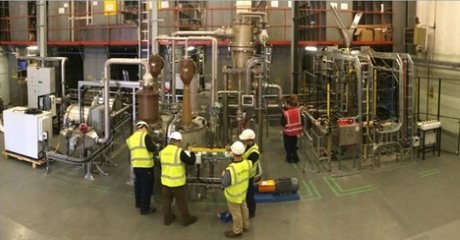A demonstration plant to vitrify radioactive waste has completed initial commissioning prior to its deployment at the UK's Sellafield site. The full-scale GeoMelt In-Container Vitrification (ICV) plant is a collaboration between the UK's National Nuclear Laboratory (NNL) and US radioactive waste management specialist Kurion.
 |
| The plant will be commissioned at the NNL's Central Laboratory next year (Image: NNL) |
The non-radioactive phase of the commissioning program concluded with a demonstration on simulated Sellafield waste, and showed that the system started up safely, reliably and met its design goals. The system will now be disassembled and moved to the NNL's Central Laboratory at Sellafield, about 25 kilometres to the south of NNL's engineering facility in Workington where the non-active testing was carried out.
The UK has over 300,000 tonnes of intermediate and low-level waste that could be suitable for treatment using GeoMelt, NNL and Kurion said. Unlike conventional vitrification technology, which requires a homogenous waste feed, GeoMelt can process various forms of waste simultaneously, and can use liabilities such as contaminated soils and inorganic ion exchange media into glass formers. It can also treat radioactive contaminated asbestos, a material found at many plants undergoing decommissioning.
The technology was initially developed by the USA's Pacific Northwest National Laboratory. It can be used to process non-radioactive hazardous wastes such as organic wastes and heavy metals, and has been used to produce a cumulative total of 26,000 tonnes of glass at various projects in Australia, Japan, the UK and the USA since the 1990s.
The NNL's GeoMelt ICV system is designed to accommodate both small test melts and full-scale melts in disposal containers with a capacity of three cubic metres. This allows for the flexibility to demonstrate, test and process radioactively contaminated and other hazardous waste streams. Lifecycle costs for waste management are lowered by the reduction of the volume of waste and its conversion to a stable form with lower packaging, storage, handling, transportation and disposal costs.
NNL and Kurion plan to increase the total throughput of the system in 2016, reaching a maximum processing capacity of more than 200 tonnes per year. The companies will also evaluate the installation of additional systems.
NNL director of waste management and decommissioning Nick Hanigan said the completion of the cold commissioning phase was a key milestone for the laboratory's core mission to evaluate options to improve the lifecycle cost for managing and dispositioning waste streams, in the UK nuclear complex, including "problematic" waste streams that currently lack a disposal path.
Kurion founder John Raymont said that the work at NNL was attracting the attention of "leading decision makers" from Europe, Japan and the USA. "We intend to use this new system as a demonstration platform for the worldwide nuclear market," he said.
Researched and written
by World Nuclear News





_18570.jpg)
_16159.jpg)
_49205.jpg)





